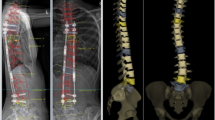Abstract
Study Design
Retrospective multicenter observational cohort study.
Objectives
To determine whether there is a significant difference in final spinal height achieved, instrumented height, or Cobb angle related to the mean time interval between distractions of dual growing rods.
Summary of Background Data
Patients were prospectively enrolled in “The Treatment of Progressive Early Onset Spinal Deformities: A Multi-Center Study.” Additional data were collected via a retrospective review of medical records.
Methods
Using data from a multicenter database, the authors identified 46 patients (23 boys and 23 girls) with early-onset scoliosis who were treated with dual growing rods and who had surgical treatment spanning more than 4 years. The patients were divided into 2 groups: those who had less than 9 months (16 patients) and those who had 9 months or more (30 patients) between distractions. Standard univariate statistics were calculated. The researchers performed 2-tailed / tests. Significance was set at p =.05.
Results
The differences in primary Cobb angle, T1–S1 height, and instrumented segment length at the last distraction or final arthrodesis, compared with the post-index procedure values, were not significantly different (p =.52,.58, and.60, respectively) between groups with the available data. The normalized instrumented height gains, in millimeters per year, were not significantly different (p =.22).
Conclusions
Patients with longer times between growing-rod distractions (9 or more months) had no significant differences in primary Cobb angle, T1–S1 length, or instrumented length gain compared with patients with shorter times (less than 9 months) between distractions.
Similar content being viewed by others
References
Moe JH, Kharrat K, Winter RB, et al. Harrington instrumentation without fusion plus external orthotic support for the treatment of difficult curvature problems in young children. Clin Orthop Relat Res 1984;185:35–45.
Thompson GH, Akbarnia BA, Campbell Jr RM. Growing rod techniques in early-onset scoliosis. J Pediatr Orthop 2007;27:354–61.
Akbarnia BA, Marks DS, Boachie-Adjei O, et al. Dual growing rod technique for the treatment of progressive early-onset scoliosis: a multicenter study. Spine (Phila Pa 1976) 2005;30:S46–57.
Yang JS, McElroy MJ, Akbarnia BA, et al. Growing rods for spinal deformity: characterizing consensus and variation in current use. J Pediatr Orthop 2010;30:264–70.
Corona J, Miller DJ, Downs J, et al. Evaluating the extent of clinical uncertainty among treatment options for patients with early-onset scoliosis. J Bone Joint Surg Am 2013;95:e67.
Sponseller PD, Yazici M, Demetracopoulos C, et al. Evidence basis for management of spine and chest wall deformities in children. Spine (Phila Pa 1976) 2007;32:S81–90.
Muirhead A, Conner AN. The assessment of lung function in children with scoliosis. J Bone Joint Surg Br 1985;67:699–702.
McMaster MJ, Macnicol MF. The management of progressive infantile idiopathic scoliosis. J Bone Joint Surg Br 1979;61:36–42.
Mehta MH. Growth as a corrective force in the early treatment of progressive infantile scoliosis. J Bone Joint Surg Br 2005;87:1237–47.
Waldron SR, Poe-Kochert C, Son-Hing JP, et al. Early onset scoliosis: the value of serial risser casts. J Pediatr Orthop 2013;33:775–80.
Bess S, Akbarnia BA, Thompson GH, et al. Complications of growing-rod treatment for early-onset scoliosis: analysis of one hundred and forty patients. J Bone Joint Surg Am 2010;92:2533–43.
Gomez JA, Lee JK, Kim PD, et al. “Growth friendly” spine surgery: management options for the young child with scoliosis. J Am Acad Orthop Surg 2011;19:722–7.
Harrington PR. Treatment of scoliosis. Correction and internal fixation by spine instrumentation. J Bone Joint Surg Am 1962;44:591–610. 634.
Akbarnia BA, Breakwell LM, Marks DS, et al. Dual growing rod technique followed for three to eleven years until final fusion: the effect of frequency of lengthening. Spine (Phila Pa 1976) 2008;33:984–90.
Watanabe K, Uno K, Suzuki T, et al. Risk factors for complications associated with growing-rod surgery for early-onset scoliosis. Spine (Phila Pa 1976) 2013;38:E464–8.
Sankar WN, Skaggs DL, Yazici M, et al. Lengthening of dual growing rods and the law of diminishing returns. Spine (Phila Pa 1976) 2011;36:806–9.
Noordeen HM, Shah SA, Elsebaie HB, et al. In vivo distraction force and length measurements of growing rods: which factors influence the ability to lengthen? Spine (Phila Pa 1976) 2011;36:2299–303.
Teli M, Grava G, Solomon V, et al. Measurement of forces generated during distraction of growing-rods in early onset scoliosis. World J Orthop 2012;3:15–9.
Yang JS, Sponseller PD, Thompson GH, et al. Growing rod fractures: risk factors and opportunities for prevention. Spine (Phila Pa 1976) 2011;36:1639–44.
Author information
Authors and Affiliations
Consortia
Corresponding author
Additional information
Author disclosures: MDP (none); PDS (none); BAA (none); GHT (son employed by nuVasive Medical Technologies); DLS (grants from POSNA, SRS; personal fees from Biomet, Medtronic; non-financial support from Growing Spine Study Group, Scoliosis Research Society, Growing Spine Foundation Medtronic Strategic Advisory Board; personal fees from expert testimony; personal fees from Biomet, Medtronic, Stryker, Wolters Kluwer Health—Lippincott Williams & Wilkins, Biomet Spine; other from Medtronic, Stryker, Biomet, Medtronic outside the submitted work; patent issued from Medtronic); JBP (none); PTN (none); SMO (none).
This study was supported by the Growing Spine Foundation.
Rights and permissions
About this article
Cite this article
Paloski, M.D., Sponseller, P.D., Akbarnia, B.A. et al. Is There an Optimal Time to Distract Dual Growing Rods?. Spine Deform 2, 467–470 (2014). https://doi.org/10.1016/j.jspd.2014.08.002
Received:
Revised:
Accepted:
Published:
Issue Date:
DOI: https://doi.org/10.1016/j.jspd.2014.08.002




